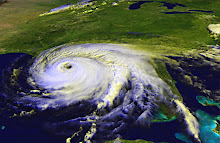Last week, my hometown was expecting some rain. What we got was a record-setting drenching that flooded more than 1,500 homes in three counties and left several roads impassable.
A lot of people were not prepared.
We have canned goods and bottled water on standby because we're getting close to hurricane season. It's nice to have stuff like that around in case of any power outage, which could be from a storm, a work crew cutting a line, or a traffic accident.
We have sandbags, because we've had a "hundred year rain" at least three times since we moved into our home ten years ago, and that's not counting hurricanes.
Thankfully, I had been hounding the county engineer, public works department, and my commissioner's office since April 1, demanding some maintenance work on our drains. They came out and did a little work, not to my satisfaction, but I have no doubt now that it kept our home from flooding.
 |
| April 29-30, 2014. Map Courtesy WEAR-TV |
I mean, look at these numbers! This map shows the massive amount of rain recorded in different areas. I don't know exactly how much fell at my house, but I live kind of between the 18" and the 26" points.
Bear in mind, our street fills up when we have two or three inches of rain. It was literally at our front porch by the time it stopped, and it did get into my husband's workshop in the back yard.
I really don't know what I would do if the water started coming in. Try to move stuff from the floor to the top of the furniture, maybe. Get the cats into their carriers and onto something tall. I heard of two dogs that drowned in their kennels before their owners realized how bad it was getting. That broke my heart. Once the water fills the street, there's no escape. The car wouldn't run through it. And I know of at least once person who drowned in her car. That broke my heart, too.
What will I do differently next time?
I'm definitely looking into flood insurance. We don't live in a flood zone, so we shouldn't "need" it, but I don't anticipate the county will correct the drainage problems we've had for ten years before we get another crazy day of rain. At this point, I would rather be safe than have to replace everything we own - and keep paying a mortgage - on a house that's unliveable.
 |
| The view out our front gate, July 2013 |
I will keep after the county to maintain the drains. They agree that the system is inadequate, but I think this event proves it can handle more than they think - if they keep it dug out and clear of weeds and trash.
I would physically move my neighbor's trash myself. She had several bags on the curb, and my husband pointed out that the water was going to get at least that high (it got higher) and she needed to move them. When he went out with his pitchfork at six in the morning and waded into the ditch to start clearing the culvert, he found her bags blocking it up. The street was mostly clear a few minutes after that.
A lot of people are asking, "When is FEMA coming?" They want their free money to buy what they need, including food and clothes. Most of the people affected don't have flood insurance; they have drainage issues like we do. But there's a procedure in place before FEMA can start passing out the checks. The local governments have to assess the damages. Then FEMA has to look for themselves and verify that it's really as bad as they're told. The area has to have a minimum amount of damage to homes, infrastructure, and businesses before your community can be declared a federal disaster area, so they have to do the math. Only then can the declaration be made.
So, be prepared to care for your family and pets for at least a week. Maybe that means canned food that will still be good if it gets wet. Maybe that means having some plastic bags to put medications in or a storage tub that you can put some clothes in before they get wet, and stick it up in the attic or on a top shelf. Sometimes really bad things happen and you will need help to recover. But be pro-active to give yourselves a few days that you can survive on your own before the U.S. Cavalry arrives.
It can happen any time and without warning.
Be safe. Be ready.








